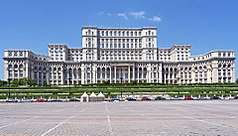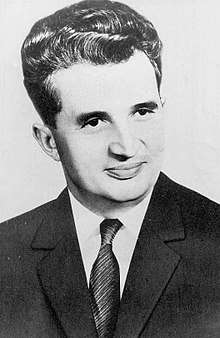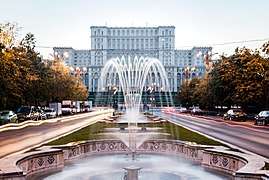Palace of the Parliament
The Palace of the Parliament (Romanian: Palatul Parlamentului) is the seat of the Parliament of Romania, located atop Dealul Spirii in Bucharest, the national capital. The Palace has a height of 84 metres (276 ft), a floor area of 365,000 square metres (3,930,000 sq ft) and a volume of 2,550,000 cubic metres (90,000,000 cu ft). The Palace of the Parliament is the heaviest building in the world, weighing about 4,098,500,000 kilograms (9.0356×109 lb).[1]
| Palace of the Parliament | |
|---|---|
Palatul Parlamentului | |
 The Palace of the Parliament in April 2018, Bucharest, Romania | |
 Location in Bucharest  Location in Romania | |
| Former names | "House of the Republic" |
| Alternative names | "The People's House" |
| General information | |
| Architectural style | Totalitarian, neoclassical |
| Address | Calea 13 Septembrie 1, Sector 5 |
| Town or city | Bucharest |
| Country | Romania |
| Coordinates | 44°25′39″N 26°5′15″E |
| Groundbreaking | 25 June 1984 |
| Completed | 1997 |
| Cost | €3 billion euros |
| Height | |
| Architectural | 84 m (276 ft) |
| Technical details | |
| Size | 240 m (790 ft) long, 270 m (890 ft) wide |
| Floor count | 12 |
| Floor area | 365,000 m2 (3,930,000 sq ft) |
| Grounds | 66,000 m2 |
| Design and construction | |
| Architect | 700 architects under the direction of chief architect Anca Petrescu (1949-2013) |
| Designations |
|
| Other information | |
| Number of rooms | 1,100 |
The building was designed and supervised by chief architect Anca Petrescu, with a team of approximately 700 architects, and constructed over a period of 13 years (1984–97) in Socialist realist and modernist Neoclassical architectural forms and styles,[2] with socialist realism in mind.[3] The Palace was ordered by Nicolae Ceaușescu (1918–1989), the dictator of Communist Romania and the second of two longtime autocrats in power in the country since World War II,[4] during a period in which the personality cult of political worship and adoration was noticeably increased for him and his family.[5] Known for its ornate interior composed of 23 sections, it houses the two houses of the Parliament of Romania: the Senate (Senat) and the Chamber of Deputies (Camera Deputaților), along with three museums and an international conference center. The several museums hosted inside the Palace are the National Museum of Contemporary Art, the Museum of Communist Totalitarianism (established in 2015)[6] and the Museum of the Palace. Though originally named the House of the Republic when under its long period of construction (Romanian: Casa Republicii), after the Romanian Revolution in December 1989 it became widely known as The People's House (Romanian: Casa Poporului). Due to its impressive endowments, events organized by state institutions and international bodies such as conferences, symposia, and others take place there, but even so about 70% of the building still remains empty.[7][8]
As of 2008, the Palace of the Parliament is valued at €3 billion ($3.4 billion), making it also the most expensive administrative building in the world.[9] The cost of heating and electric use and lighting alone exceeds $6 million per year, comparable to the total cost for powering a medium-sized city.[10]
Location
The Palace is located in Sector 5 in the central part of Bucharest, at the top of Dealul Spirii (Spirea's Hill), also known as Dealul Arsenalului (Arsenal Hill). It is situated at the west end of the 3.5 kilometer (2.2 mile) Bulevardul Unirii (Union Boulevard), constructed simultaneously with the Palace, and is framed by Izvor Street to the west and northwest, United Nations Avenue to the north, Liberty Avenue to the east and Calea 13 Septembrie to the south.
History

.jpg)
The building of the Palace of the Parliament was the most extreme expression of the systematization program imposed by Nicolae Ceaușescu upon Romania. The systematization was a program of urban planning carried out by Ceaușescu, who was impressed by the societal organization and mass adulation in North Korea's Juche ideology during his East Asia visit in 1971, and decided to implement similar policies in Romania, with the stated goal of turning Romania into a "multilaterally developed socialist society".
The Vrancea earthquake of 4 March 1977 gave Ceaușescu a pretext to demolish parts of old Bucharest.[12] He wanted a civic center more in line with the country's political stance, started a reconstruction plan of Bucharest based on socialist realism style.[3] The House of the Republic (later The People's House after the 1989 Revolution) was the center of this project. Named Project Bucharest, it was an ambitious project of Ceaușescu's begun in 1978 as an intended replica of Pyongyang, the capital of North Korea. A systematization project existed since the 1930s (during the time of King Carol II) for the Unirii–Dealul Arsenalului area. Its construction was organized as a contest and won by Anca Petrescu (1949-2013), who was appointed chief architect of the project when she was just age 28. In total, the team that coordinated the work was made up of 10 assisting architects, which supervised a further lower 700.[13] Construction of the Palace began on 25 June 1984, and the inauguration of the work was attended by Ceaușescu and frequently inspected personally.
The building was also erected on the site of some monasteries that were demolished and on the site of Uranus Hill that was leveled. In this area were previously located the National Archives, Mihai Vodă Monastery, Brâncovenesc Hospital,[14] as well as about 37 old factories and workshops.[15] Demolition in the Uranus area began in 1982. 7 square kilometres (2.7 sq mi) of the old city center was demolished, with 40,000 people being relocated from this area.[16] The works were carried out with forced labor of soldiers and so the cost was minimized.[17]
Between 20,000 and 100,000 people worked on the site and project, operating in three shifts of 5,000 soldiers of the Romanian Army and huge numbers of "volunteers".[18] Thousands of workers died in connection with the construction of the House of the Republic / People's House, some sources mention a figure of 3,000 people lost.[19]
In 1989, the building costs were estimated at $1.75 billion, and in 2006 at €3 billion. In 1990, Australian-born business and media magnate Rupert Murdoch wanted to buy the building for US$1 billion, but his bid was rejected.[20]
After 1989
Since 1994, the building hosts the Chamber of Deputies, after the initial headquarters of the institution, the Palace of the Chamber of Deputies (now the Palace of the Patriarchate), was donated by the State to the Romanian Orthodox Church. Since 2004 the Romanian Senate has been headquartered in the Parliamentary Palace and was originally housed in the former building of the Central Committee of the Romanian Communist Party.
Six years after the Palace's completion, between 2003 and 2004, a glass annex was built alongside the external elevators.[21] This was done to facilitate outside access to the National Museum of Contemporary Art which opened in 2004 inside the west wing of the Palace. In the same period, a project aiming to hoist a huge flag was canceled following protests from the public. A flag was already hoisted on the building, but was removed together with the support.
The restaurant, accessible only to politicians, was refurbished. Since 1998 the building houses an office for the Regional Southeast European Cooperative Initiative (SECI) Center for Fighting Transborder Crime.[22]
In 2008, the Palace hosted the 20th NATO summit for the North Atlantic Treaty Organization. In 2010, politician Silviu Prigoană proposed re-purposing the building into a shopping centre and an entertainment complex. Citing costs, Prigoană said that the Romanian Parliament should move to a new building, since they occupied only 30% of the interior of the massive palace. While the proposal has sparked a debate in Romania, another politician Miron Mitrea dismissed the idea as a "joke".[23]
The Palace has also been the background of several motorsports events, including the 2011 Drift Grand Prix Romania, which brought together professional drifters from all over Europe.[24]
Copyrights over the building's image
Although the Palace of the Parliament was financed from public funds and the architects did a work for hire, after the death of Anca Petrescu, the chief architect of this colossal building, her heirs sued the Inferior Chamber of the Romanian Parliament for using the image of the iconic building without authorization. The institution was accused of selling photos and souvenirs depicting the building's image.[25] Besides the copyright infringement of the architectural works, in several ongoing trials the heirs claims the violation of trademarks, owned by the chief architect, and depicting the Palace of the Parliament from different angles.[26]
While the legal experts consider there are no restrictions for tourists wishing to photograph the iconic building for non-commercial purposes,[26] the heirs of Anca Petrescu have clearly set out that any commercial use of the building's image is subject to a 2% royalty fee.[25] It is believed this situation could have been avoided if an agreement between the chief architect and the beneficiary (Romanian State) had addressed the intellectual property rights and Romania had implemented Freedom of Panorama, restricting the scope of copyright law in a such case.[26]
Technical details
.jpg)
The construction of the Palace began in 1984 and initially should have been completed in only two years. The term was then extended until 1990, but even now it is not finalized. Only 400 rooms and two meeting rooms are finished and used, out of 1,100 rooms.
The building has eight underground levels, the last one being a nuclear bunker, linked to the main state institutions by 20 km of catacombs.[27] Nicolae Ceaușescu feared nuclear war. The bunker is a room with 1.5 m thick concrete walls and can not be penetrated by radiation. The shelter is composed of the main hall – headquarters that would have had telephone connections with all military units in Romania – and several residential apartments for state leadership, in the event of war.
The building has a developed area of 365,000 m2, making it the world's third-largest administrative building, after The Pentagon and Long'ao Building, and in terms of volume, with its 2.55 million m3, it is among the most massive.[28] For comparison, it can be mentioned that the building exceeds by 2% the volume of the Great Pyramid of Giza along the Nile River in Egypt,[29] and therefore some sources label it as a "pharaonic" construction.[30]
The building of the Palace of the Parliament sinks by 6 mm each year because of its weight.[31] Romanian specialists who analyzed the data argue that massive weight and structure of the Palace lead to the settlement of layers below the construction.
Materials
.jpg)
The building was constructed almost entirely of materials of Romanian origin. The only exceptions are the doors of Nicolae Bălcescu Hall. These were received by Ceaușescu as a gift from his friend Mobutu Sese Seko (Joseph Mobutu), the longtime President and similar dictator of Zaire in Central Africa (now the Democratic Republic of the Congo).[33]
Among them: 3,500 tonnes of crystal – 480 chandeliers, 1,409 ceiling lights and mirrors were manufactured; 700,000 tonnes of steel and bronze for monumental doors and windows, chandeliers, and capitals; 1,000,000 cubic metres (35,000,000 cu ft) of marble,[33] 900,000 cubic metres (32,000,000 cu ft) of wood[34] (over 95% domestic) for parquet and wainscotting, including walnut, oak, sweet cherry, elm, sycamore maple; 200,000 square metres (2,200,000 sq ft) of woolen carpets of various dimensions (machines had to be moved inside the building to weave some of the larger carpets); velvet and brocade curtains adorned with embroideries and passementeries in silver and gold.
Gallery
 Palace of the Parliament seen from the Unirii Boulevard
Palace of the Parliament seen from the Unirii Boulevard.jpg) Inside the Palace of the Parliament
Inside the Palace of the Parliament.jpg) International Conference Centre
International Conference Centre.jpg) The Palace of the Parliament in June 1996, a year short of completion
The Palace of the Parliament in June 1996, a year short of completion
See also
- Seven Wonders of Romania
References
- "Heaviest building". Guinness World Records.
- "Anca Petrescu". 11 July 2018.
- "Vlad Bodogan: Architecture of oppression: an analyses of the socio-political implications behind the construction of Casa Scânteii". Pavilion Magazine. 11 July 2018.
- "Megalomania lui Ceaușescu: dorința de a merge pe sub București și povestea catacombelor secrete". 11 June 2018.
- "Se muncea, dar se și murea. Povești cutremurătoare de pe șantierele lui Ceaușescu". 11 July 2018.
- "Senatul a adoptat legea privind infiintarea Muzeului Totalitarismului Comunist. Academia Romana va intocmi si un raport de condamnare a comunismului". HotNews.ro. 22 September 2015.
- "Palatul Parlamentului, o emblema a Bucurestiului". Hotel-Bucuresti.com.
- John Malathronas (5 December 2014). "Palace of the damned dictator: On the trail of Ceausescu in Bucharest". CNN.
- "Casa Poporului - de trei ori în Cartea Recordurilor". Gândul. 4 April 2008.
- Andrei Pandele (September 2008). "Palatul Parlamentului din Casa Poporului". National Geographic România.
- Roxana Ruscior (21 August 2014). ""Ceauşima" – cum a fost demolat cartierul Uranus". Descoperă.ro.
- "Demolarea casei Grigore Cerkez după cutremurul din 1977". 11 July 2018.
- "De la Casa Poporului la Palatul Parlamentului. Istoria clădirii care a intrat de trei ori în Cartea Recordurilor". Digi24. 31 October 2013.
- "Spitalul Brâncovenesc nu trebuia să cadă!". Ziarul Ring. 22 February 2010.
- "Atunci si acum: Casa Poporului". Metropotam. 9 June 2009.
- "The Palace of the Parliament in Bucharest", Radio Netherlands Archives, November 19, 1997
- Ioan Popa (1992). Robi pe Uranus (I ed.). Humanitas. ISBN 973-28-0304-5.
- "Şantierele groazei. Cum s-au construit cu sânge mastodonţii doriţi de Ceauşescu: Casa Poporului, Canal, Transfăgărăşan şi Bicaz". 11 July 2018.
- Anca Murgoci (8 November 2013). "Peste ce s-a construit Casa Poporului. Vezi imagini din 1982". DC News.
- "Detalii nestiute despre Casa Poporului, cea mai scumpa cladire administrativa din lume". Stirile Pro TV. 16 May 2013.
- Mariusz Czepczynski (June 2008). Cultural Landscapes of Post-Socialist Cities. Ashgate. ISBN 978-0-7546-7022-3.
- "South-East Europe Cooperative Initiative (SECI)". Ministry of Foreign Affairs of the Republic of Serbia. Archived from the original on 2 November 2015.
- Matthew Day (4 February 2010). "Nicolae Ceausescu palace 'to be turned into shopping mall'". The Telegraph.
- "Guest Blog: Drift.ro>> Sideways in Romania's Capital - Speedhunters". Speedhunters. 29 October 2011. Retrieved 13 February 2018.
- "Bătălia pentru imaginea Palatului Parlamentului. Decizia luată de OSIM". Stirileprotv.ro. Retrieved 2 November 2018.
- "Taking photos of the Palace of Parliament can be considered illegal". dpvue. Retrieved 2 November 2018.
- "Secretele Casei Poporului | "Ceauşescu voia să umble cu maşina pe sub Bucureşti"". Libertatea. 21 February 2011.
- "La plimbare prin subsolul Casei Poporului". Adevărul. 26 March 2010.
- "Lucruri mai putin stiute despre Casa Poporului - cea mai mare cladire din Europa". Metropotam. 4 March 2015.
- "Casa Poporului". TravelWorld.ro.
- "Casa Poporului se scufundă în sol în fiecare an. Ce spun specialiştii despre acest "fenomen"". Gândul. 26 December 2014.
- "VITROMETAN, locul unde 2 ani s-a lucrat la candelabrele din Casa Poporului. De la moda peştelui din sticlă colorată aşezat pe mileul de pe televizor la planul pentru supravieţuire". Mediafax. 26 March 2013.
- "7 Amazing Facts about The Palace of The Parliament in Bucharest". YourAmazingPlaces.com.
- "Casa Poporului". Archived from the original on 8 December 2015.
External links
| Wikimedia Commons has media related to Palace of the Parliament of Romania. |